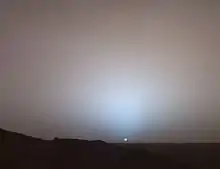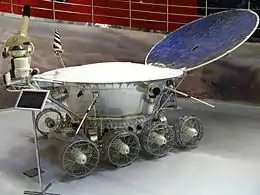List of rovers on extraterrestrial bodies
A rover is a planetary surface exploration vehicle designed to move across the surface of a planet or other celestial body. Rovers are used to explore, collect information and take samples of the surface. This is a list of all rovers on extraterrestrial bodies in the Solar System. Since 1970, there have been four lunar rovers (excludes the three Lunar Roving Vehicles on Apollo 15, 16, 17 as they were carried no payloads and were just meant for moving the astronauts, their equipments and lunar samples on lunar surface from one place to another), four mars rovers, and 3 asteroid rovers that have successfully landed and roved on these extraterrestrial surfaces.
Key
Colour key:
| – Mission completed successfully (or partially successfully) | – Failed or cancelled mission | ||
| – Mission en route or in progress (including mission extensions) | – Planned mission |
Moon
| Mission | Rover | Country/Agency | Date of landing | Coordinates | Operational time | Distance travelled | Notes |
|---|---|---|---|---|---|---|---|
| Luna 17 | Lunokhod 1 | 17 November 1970 | 38.2378°N 35.0017°W | 322 days | 10.5 km (6.5 mi) | First rover on extraterrestrial body | |
| Luna 21 | Lunokhod 2 | 15 January 1971 | 25.85°N 30.45°E | 236 days | 39 km (24 mi) | Farthest distance traveled on the Moon. | |
| Chang'e 3 | Yutu | 14 December 2013 | 44.12°N 19.51°W | 42 days (mobile) 973 days (total) | 114.8 m (377 ft) | First Chinese extraterrestrial rover and first soft landing on the Moon in over 35 years. Immobile after 42 days from landing. | |
| Chang'e 4 | Yutu-2 | 3 January 2019 | 44.8°S 175.9°E | 762 days | 565.9 m (1,857 ft)[1] as of 25 October 2020 | First soft landing on the far side of the Moon. Longest fully functioning rover on the Moon. | |
| Chandrayaan-2 | Pragyan | 6 September 2019 | 70.90°S 22.78°E | 0 days | 0 km | Lost when Vikram lander crash landed on the Moon | |
| VIPER | December 2022 | 100 days (planned) | |||||
Mars
| Mission | Rover | Country/Agency | Date of landing | Coordinates | Operational time | Distance travelled | Notes |
|---|---|---|---|---|---|---|---|
| Mars 2 | Prop-M Rover | 27 November 1971 | 45°S 47°E | 0 days | 0 km | Lost when Mars 2 lander crash landed on Mars | |
| Mars 3 | Prop-M Rover | 2 December 1971 | 45°S 202°E | 0 days | 0 km | Lost when Mars 3 lander stopped communicating about 20 seconds after landing | |
| Mars Pathfinder | Sojourner | 5 July 1996 | 38.2378°N 35.0017°W | 85 days | 100 m (330 ft) | First successful rover on Mars | |
| Mars Exploration Rover | Spirit | 4 January 2004 | 14.5684°S 175.472636°E | 2269 days | 7.73 km (4.80 mi) | ||
| Opportunity | 25 January 2004 | 1.9462°S 354.4734°E | 5498 days | 45.16 km (28.06 mi) | Longest distance travelled by any rover and most days operated | ||
| Mars Science Laboratory | Curiosity | 25 January 2012 | 4.5895°S 137.4417°E | 3103 days | 22.97 km (14.27 mi)[2] as of 22 July 2020 | Currently active | |
| Mars 2020 | Perseverance | 18 February 2021 | 18.3793167°N 77.5792887°E | 668 days (planned) | En route - successfully launched from Cape Canaveral on July 30, 2020 | ||
| Tianwen-1 | April 2021 | En route | |||||
| ExoMars | Rosalind Franklin | 2023 | 18.275°N 335.368°E | 420 days (planned) | Planned to launch 2022 | ||
Asteroids
| Body | Mission | Rover | Country/Agency | Date of landing | Location | Operational time | Distance travelled | Notes |
|---|---|---|---|---|---|---|---|---|
| 162173 Ryugu | Hayabusa2 | MINERVA-II Rover-1A | 21 September 2019 | Tritonis | 36 days[3] | Successfully landed, returned images, and hopped along surface. First rovers on an asteroid. | ||
| MINERVA-II Rover-1B | 3 days[3] | Successfully landed, returned images, and hopped along surface. First rovers on an asteroid. | ||||||
| MASCOT | 3 October 2018 | Alice's Wonderland | 17 h 14 min[4] | ~17.9 m (59 ft)[4] | Successfully landed, returned images from the surface, and performed multiple hops along surface | |||
| MINERVA-II Rover-2 | October 2019 | Unknown | 0 days | 0 m | Failed before deployment, so it was released in orbit around the asteroid to perform gravitational measurements before it impacted a few days later |
Gallery
 Spirit artificially added to image (taken by itself) of Larry's Lookout
Spirit artificially added to image (taken by itself) of Larry's Lookout Spirit Martian sunset by Spirit at Gusev crater, May 19, 2005.
Spirit Martian sunset by Spirit at Gusev crater, May 19, 2005. Lunokhod 1 Soviet Lunokhod moonrover from the 1970s.
Lunokhod 1 Soviet Lunokhod moonrover from the 1970s.
See also
References
- "China's lunar rover travels 565.9 meters on moon". China Internet Information Center. 25 October 2020. Retrieved 8 November 2020.
- "Where Is Curiosity?". mars.nasa.gov. NASA. Retrieved 22 July 2020.
- Yoshimitsu, Tetsuo; Kubota, Takashi; Tomiki, Atsushi; Yoshikaw, Kent (2019-10-24). Operation results of MINERVA-II twin rovers onboard Hayabusa2 asteroid explorer (PDF). 70th International Astronautical Congress. International Astronautical Federation. Retrieved 2020-01-25.
- Davis, Jason (28 August 2019). "Hayabusa2 Lander Mania: Results from MASCOT, Plans for MINERVA-II2". The Planetary Society. Retrieved 2020-01-25.
This article is issued from Wikipedia. The text is licensed under Creative Commons - Attribution - Sharealike. Additional terms may apply for the media files.
.jpg.webp)